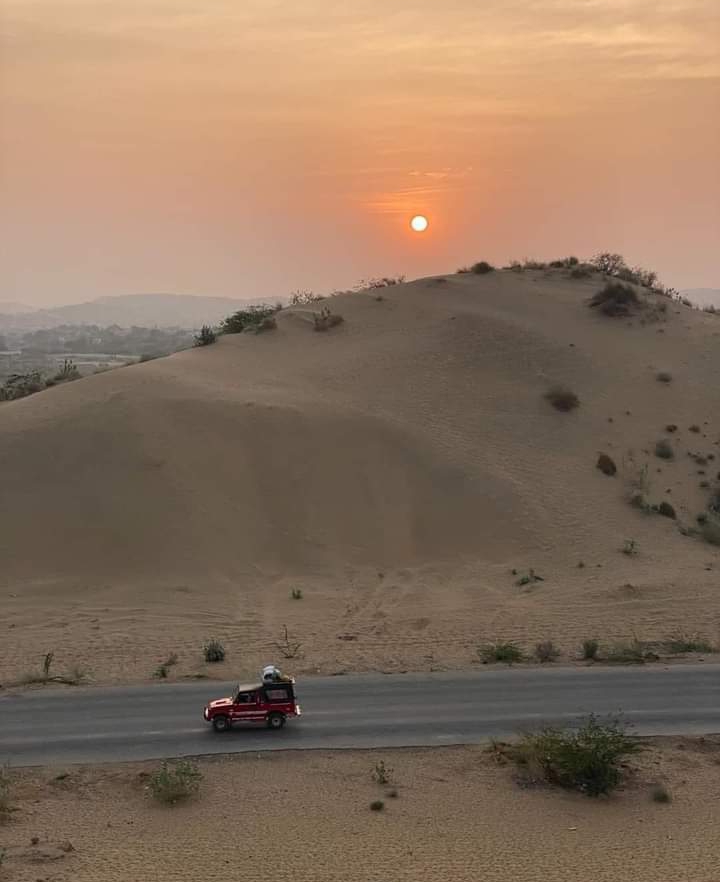Golden sands whisper tales of survival
Tharparkar, one of Pakistan’s most disadvantaged regions

Tharparkar’s story is far from over; it is waiting to be rewritten. It is more than just a desert; it is a land of resilience, culture, and untold stories
Zaheer Udin Babar Junejo
Tharparkar, a sprawling desert district in southeastern Sindh, Pakistan, is a land of striking contrasts where vibrant cultures thrive amidst harsh living conditions, where golden sand dunes stretch endlessly under a relentless sun, and where the indigenous communities once displayed remarkable resilience in the face of adversity. With a population of over 1.5 million people and nearly six million livestock, Tharparkar is one of Pakistan’s most disadvantaged regions. Poverty is widespread, basic services are scarce, and the unforgiving climate, marked by recurring droughts, scorching heat, and erratic rainfall, makes survival a daily struggle. Yet, despite these challenges, the people of Thar have preserved their rich traditions, communal harmony, and an unyielding spirit.
 The discovery of Thar’s coal reserves promised jobs and progress. However, the benefits have largely bypassed the local population
The discovery of Thar’s coal reserves promised jobs and progress. However, the benefits have largely bypassed the local population
Historians believe that thousands of years ago, the Thar Desert lay beneath the Arabian Sea. As the waters receded, the land transformed into a vast arid expanse, later becoming home to various tribes migrating from Sindh and Rajasthan. Today, Tharparkar stands as a testament to unity in diversity, where Rajputs, Sumras, and Darawars coexist in harmony, sharing wells, guest houses (Otaque), and a collective way of life. The villages, often perched atop dunes to escape the stifling heat, are clusters of dome-shaped thatched huts called Chounras. Each village, typically housing up to 500 people, is organized into Paras (hamlets), where communities live together under the leadership of a Patel (village headman). This social structure fosters cooperation while maintaining a delicate balance between different castes and livelihoods.

Tharparkar’s most pressing crisis is the acute shortage of clean drinking water. In a recent report from FRDP highlighting the emerging drought situation, out of the surveyed 9,809 water schemes in the district, 4,135 are dysfunctional, forcing women and children to trek miles in search of water. Many depend on brackish, contaminated wells, leading to widespread waterborne diseases like diarrhea and cholera. Droughts strike Tharparkar seven times in a decade, pushing nearly 40% of the population to migrate temporarily. Men from lower castes seek labor in the Indus plains, while others move to urban centers, working in homes and restaurants for meager wages. A recent report from the FRDP indicates that 14,490 people from 127 villages have already migrated due to resource scarcity. For the people of Thar, livestock is not just a source of income but a way of life. However, with fodder scarcity and plummeting animal health, livestock prices have dropped by 23%. Many families are forced to sell their precious animals at throwaway prices, further deepening their poverty.
A disturbing trend has emerged in increased suicide rates among lower-caste Hindus, possibly due to economic despair and loss of ancestral livelihoods
Tharparkar has one of the highest child and maternal mortality rates in Pakistan. Malnourished mothers give birth in makeshift huts, with no access to proper healthcare. Outbreaks of malaria, respiratory infections, and flu are common, with infants being the most vulnerable. The lack of nutrition and clean water exacerbates the suffering. In recent years, Tharparkar has seen mega development projects, including coal mining, road infrastructure, and cellular networks. While these initiatives have brought some economic activity for the opportunists, they have also disrupted traditional livelihoods and widened social divides.
 The discovery of Thar’s coal reserves promised jobs and progress. However, the benefits have largely bypassed the local population. Instead, land acquisition disputes and environmental degradation have left many communities displaced and disillusioned.
The discovery of Thar’s coal reserves promised jobs and progress. However, the benefits have largely bypassed the local population. Instead, land acquisition disputes and environmental degradation have left many communities displaced and disillusioned.
Read – Tharparkar: The Land of Hope and Transformation
A disturbing trend has emerged in increased suicide rates among lower-caste Hindus, possibly due to economic despair and loss of ancestral livelihoods. The rapid changes have left many feeling alienated in their land. Tharparkar’s plight demands urgent attention. While NGOs and government initiatives have made some progress, long-term, community-driven solutions are needed. Tharparkar is more than just a desert; it is a land of resilience, culture, and untold stories. Its people, though burdened by hardship, continue to uphold their traditions with dignity. The challenges are immense, but with inclusive policies and genuine commitment, Thar can transition from a region of despair to one of hope. For now, the golden sands whisper tales of survival, and the winds carry the echoes of a people who refuse to be forgotten. Tharparkar’s story is far from over; it is waiting to be rewritten.
Read: The hazards of coalmines in Tharparkar
__________________
 Zaheer Udin Babar Junejo is a Community Driven Development Specialist based in Hyderabad.
Zaheer Udin Babar Junejo is a Community Driven Development Specialist based in Hyderabad.

 The discovery of Thar’s coal reserves promised jobs and progress. However, the benefits have largely bypassed the local population
The discovery of Thar’s coal reserves promised jobs and progress. However, the benefits have largely bypassed the local population


